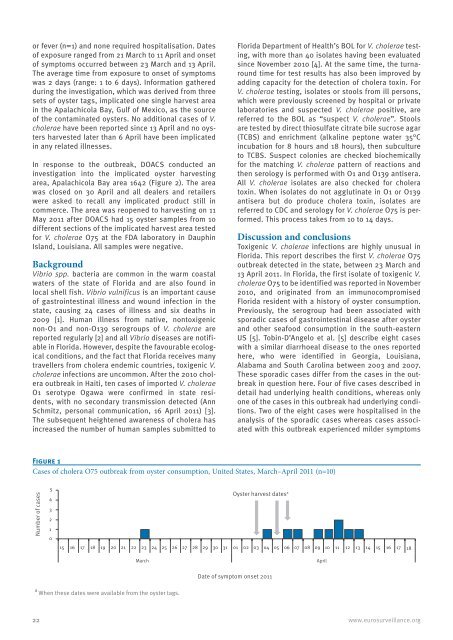Escherichia coli - Eurosurveillance
Escherichia coli - Eurosurveillance
Escherichia coli - Eurosurveillance
You also want an ePaper? Increase the reach of your titles
YUMPU automatically turns print PDFs into web optimized ePapers that Google loves.
or fever (n=1) and none required hospitalisation. Dates<br />
of exposure ranged from 21 March to 11 April and onset<br />
of symptoms occurred between 23 March and 13 April.<br />
The average time from exposure to onset of symptoms<br />
was 2 days (range: 1 to 6 days). Information gathered<br />
during the investigation, which was derived from three<br />
sets of oyster tags, implicated one single harvest area<br />
in the Apalachicola Bay, Gulf of Mexico, as the source<br />
of the contaminated oysters. No additional cases of V.<br />
cholerae have been reported since 13 April and no oysters<br />
harvested later than 6 April have been implicated<br />
in any related illnesses.<br />
In response to the outbreak, DOACS conducted an<br />
investigation into the implicated oyster harvesting<br />
area, Apalachicola Bay area 1642 (Figure 2). The area<br />
was closed on 30 April and all dealers and retailers<br />
were asked to recall any implicated product still in<br />
commerce. The area was reopened to harvesting on 11<br />
May 2011 after DOACS had 15 oyster samples from 10<br />
different sections of the implicated harvest area tested<br />
for V. cholerae O75 at the FDA laboratory in Dauphin<br />
Island, Louisiana. All samples were negative.<br />
Background<br />
Vibrio spp. bacteria are common in the warm coastal<br />
waters of the state of Florida and are also found in<br />
local shell fish. Vibrio vulnificus is an important cause<br />
of gastrointestinal illness and wound infection in the<br />
state, causing 24 cases of illness and six deaths in<br />
2009 [1]. Human illness from native, nontoxigenic<br />
non-O1 and non-O139 serogroups of V. cholerae are<br />
reported regularly [2] and all Vibrio diseases are notifiable<br />
in Florida. However, despite the favourable ecological<br />
conditions, and the fact that Florida receives many<br />
travellers from cholera endemic countries, toxigenic V.<br />
cholerae infections are uncommon. After the 2010 cholera<br />
outbreak in Haiti, ten cases of imported V. cholerae<br />
O1 serotype Ogawa were confirmed in state residents,<br />
with no secondary transmission detected (Ann<br />
Schmitz, personal communication, 16 April 2011) [3].<br />
The subsequent heightened awareness of cholera has<br />
increased the number of human samples submitted to<br />
Florida Department of Health’s BOL for V. cholerae testing,<br />
with more than 40 isolates having been evaluated<br />
since November 2010 [4]. At the same time, the turnaround<br />
time for test results has also been improved by<br />
adding capacity for the detection of cholera toxin. For<br />
V. cholerae testing, isolates or stools from ill persons,<br />
which were previously screened by hospital or private<br />
laboratories and suspected V. cholerae positive, are<br />
referred to the BOL as “suspect V. cholerae”. Stools<br />
are tested by direct thiosulfate citrate bile sucrose agar<br />
(TCBS) and enrichment (alkaline peptone water 35°C<br />
incubation for 8 hours and 18 hours), then subculture<br />
to TCBS. Suspect colonies are checked biochemically<br />
for the matching V. cholerae pattern of reactions and<br />
then serology is performed with O1 and O139 antisera.<br />
All V. cholerae isolates are also checked for cholera<br />
toxin. When isolates do not agglutinate in O1 or O139<br />
antisera but do produce cholera toxin, isolates are<br />
referred to CDC and serology for V. cholerae O75 is performed.<br />
This process takes from 10 to 14 days.<br />
Discussion and conclusions<br />
Toxigenic V. cholerae infections are highly unusual in<br />
Florida. This report describes the first V. cholerae O75<br />
outbreak detected in the state, between 23 March and<br />
13 April 2011. In Florida, the first isolate of toxigenic V.<br />
cholerae O75 to be identified was reported in November<br />
2010, and originated from an immunocompromised<br />
Florida resident with a history of oyster consumption.<br />
Previously, the serogroup had been associated with<br />
sporadic cases of gastrointestinal disease after oyster<br />
and other seafood consumption in the south-eastern<br />
US [5]. Tobin-D’Angelo et al. [5] describe eight cases<br />
with a similar diarrhoeal disease to the ones reported<br />
here, who were identified in Georgia, Louisiana,<br />
Alabama and South Carolina between 2003 and 2007.<br />
These sporadic cases differ from the cases in the outbreak<br />
in question here. Four of five cases described in<br />
detail had underlying health conditions, whereas only<br />
one of the cases in this outbreak had underlying conditions.<br />
Two of the eight cases were hospitalised in the<br />
analysis of the sporadic cases whereas cases associated<br />
with this outbreak experienced milder symptoms<br />
Figure 1<br />
Cases of cholera O75 outbreak from oyster consumption, United States, March–April 2011 (n=10)<br />
Number of cases<br />
5<br />
4<br />
3<br />
2<br />
1<br />
0<br />
Oyster harvest dates a<br />
15 16 17 18 19 20 21 22 23 24 25 26 27 28 29 30 31 01 02 03 04 05 06 07 08 09 10 11 12 13 14 15 16 17 18<br />
a When these dates were available from the oyster tags.<br />
March April<br />
Date of symptom onset 2011<br />
22 www.eurosurveillance.org

















